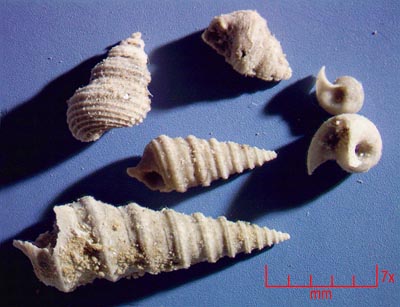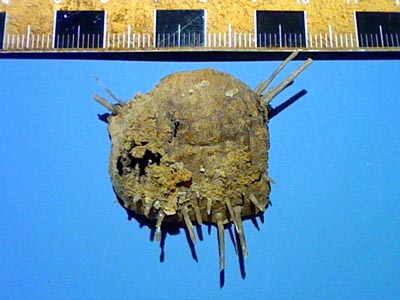|
The area
around OW Ranch is ripe with Paleozoic formations such as the
Naco, Redwall, Martin and of course the Fort Apache Limestone.
We found this outcrop will driving back from a successful fossil
hunt in the Naco formation with our friend John Christian looking
for rare productids. The side of the road had occasional blocks
of limestone from the cliffs above, but none was accessible.
Then we found one small exposure that seemed to contain a wealth
of calcified fossils. But we are looking for the small silicified
fossils that are in the rock and can be freed with various acid
treatments. So we picked up a half dozen baseball sized rocks
from this outcrop and headed home, with the thought that we could
take a chance on there being a few isolated silicified fossils
somewhere in the rock samples. After a few days of acid baths
in the backyard (3 gallons of Muriatic diluted to about 30%),
we had a fine collection of silicified specimens!
Photographing the
fossils
Here, you will
find both low magnification web cam shots with a centimeter scale
for the largest specimens, and many microscope shots. The microscope
is an Amscope trinocular stereo for use in examining biological
specimens. The camera mounts right on the microscope and provides
10 mega pixel images. Up to 12 images are taken of each specimen
at a different focus and combined as one sharp image using picolay
software. This allows a huge range of focus to be seen in each
image, from the top of a tall specimen to the base sharp and
crisp.
CLICK on these
thumbnails for the larger high resolution view!

|
The
locality is a low cliff where the Fort Apache comes right down
to road level and many of the fallen pieces are loaded with calcified
fossils. But no visible silicified fossils were seen. Would there
be anything left after the acid bath? |

|
Out
of 5 rocks ranging from hand size to baseball sized we obtained
this from the acid fines. Three different sieves are used to
isolate different sizes. Of course any calcified fossils are
dissolved away, but what remains are the silicified fossils and
about 15% dirt. It takes about a week to remove the specimens
from this matrix. |

|
Some
of the larger gastropods were found, but none of the super small
microscopic specimens were there. |

|
Bellerophon
Monoplacophoran. This is a cut in half specimen - maybe when
the rock broke free of the outcrop that shows the interior coils
of this gastropod like animal. |

|
Bellerophon,
same specimen with the web cam. |

|
Another
Bellerophontid, nearly perfect. Preservation is a bit coarse
in this limestone, not as good for small microfossils, but contains
many larger specimens. The big V groove on the leading edge of
the shell is characteristic of this genus. |

|
Top
view of another Bellerophon. Note the backbone like ridge on
the outside. Monoplacophorans are very primitive mollusks that
lived in parallel with normal gastropods. |

|
Bellerophon,
best specimen with the web cam. They are very thin shelled and
if you try to pick one up with your fingers it will most likely
shatter. (The voice of experience...) |

|
Bryozoans,
tiny forked branches. Each tiny pit in the branch was a tiny
animal living in this colony. They are rare but still show amazing
details. |

|
Larger
very flattened bryozoan. The preservation did not record the
tiny pores for the animals. These were very rare at Highland
Trail localities. |

|
Large
branching bryozoan. The dark band at the top was what was actually
sticking out of the rock and is darkened by desert varnish. The
rest was hiding inside the limestone! |

|
Clams
- This pair of somewhat flattened mollusks were the largest found
in the samples. |

|
Many
very tiny clams too, but as I mentioned earlier, the preservation
of this layer favors larger organisms and leaves the really small
ones a bit pitted and recrystallized. |

|
More
tiny clams. The one at the top has a wing. |

|
High
power close up of a very nice small clam. |

|
Huge
golf ball sized productid brachiopod. Note the superb preservation
of the spines which kept it from sinking or anchored it in the
soft bottom mud. |

|
A
few more larger productids, not as well preserved. Probably Productus
sp. |

|
Under
the microscope we found a few broken off productid spines. |

|
Small
scaphopods. This is also a mollusk, cone shaped and up to three
inches long when found complete. |

|
A
mix of scaphopods and sea urchin spines found in the rocks we
brought back. |

|
Scaphopod
Teleoconch, these are juvenile scaphopods that have not yet developed
their linear ornamentation. |

|
An
extremely rare find! This is a tiny rugose coral.
We had only found ONE of them at the other sites after going
through hundreds of pounds of rock in the acid bath. |

|
Microscope
close up of this remarkably rare specimen. |

|
End
on view. |

|
ONLY
two ostracods were found! These tiny clam like shrimp were super
abundant in at our other Highland Trail locality. When I say
abundant - I mean tens of thousands of them. Part of this is
due to the poor preservation of tiny fossils here but mostly
they are a different layer. |

|
A
surprise find was 5 piece of a calcitic (now silicified) sponge.
Most piece are pea sized, but one was a bit larger. These were
very rare at the Highland Trail site. |

|
Four
of the five sponges we found. Its amazing that we only had a
few handfuls of rock and found FIVE. In the entire 500+ pounds
of rock we put through the acid bath from the Highland trail
site, we only got a few. |

|
A
cross section of a sponge. This one is sliced down the middle
to show the inside is also quite "spongy" looking. |
|






























